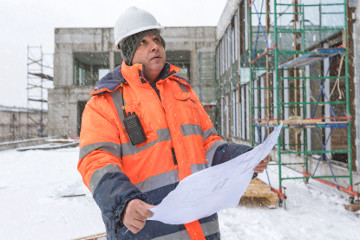- Home
- Loss Control
- Loss Control Insights
- Carbon Monoxide: The Wintertime Hazard You’ll Never See Coming
It’s cold outside. If you’re lucky, you managed to get your project’s outside perimeter closed up before the temps dropped, and now you’re working in relative comfort thanks to a few salamander heaters. With the help of some generators and propane-powered forklifts you’re probably getting a lot done, too. What could go wrong?
A Hazard You Can’t See or Smell
Carbon monoxide is an odorless, colorless and tasteless gas that is imperceptible at low levels. It’s released as a product of combustion, so any time you burn fuel (cars, generators, fireplaces, propane-powered forklifts) you are also releasing carbon monoxide into the surrounding area.
Carbon monoxide is generally not an issue when you’re working outside, but it can build up in enclosed spaces, eventually climbing to a level that is poisonous to people who breathe it in. Symptoms include headaches, dizziness, weakness, upset stomach, chest pain and confusion. A high level of exposure can be fatal.
Because it’s invisible, carbon monoxide is often not noticed until people start experiencing the physical effects of poisoning, but there are ways you can manage this risk proactively.
Some Work Areas are More Vulnerable than Others
Many workplaces have enough natural ventilation that a buildup of carbon monoxide isn’t likely to occur under normal circumstances. A building’s envelope is likely unsecured in many places, or there may be gaps where utilities or equipment enter and exit the site. Even the normal opening and closing of doors as people come and go may provide enough air exchange to keep carbon monoxide levels in check for work areas that don’t produce much of the gas.
However, if you are running equipment powered by fossil fuels (e.g. gasoline, propane, natural gas, diesel, kerosene, number 2 fuel oil) indoors, then carbon monoxide should definitely be on your risk radar. You will also want to be especially vigilant if your work areas are located in a basement, simply because basements generally have less natural ventilation than areas at ground level or higher.
Heaters are a Common Culprit, Especially When They Need Service
While any fuel-burning tool or equipment could release carbon monoxide, portable heaters are some of the most common risks we see, especially this time of year. You’ve probably chosen your heater based on the type of work you’re doing and the outside temps, but don’t forget to consider safety as well.
Direct Fired vs. Indirect Fired
A direct fired heater forces air directly through a flame to heat it, making these units very effective but also more likely to release carbon monoxide with the exhaust. An indirect fired heater works more like your home furnace where air is warmed as it passes over a heating element, then it is circulated through ductwork to the work area.
While there are pros and cons to each type of unit, the indirect heaters give you a little more flexibility with your exhaust. You can keep the unit inside (while venting the exhaust to the outside), or you can place the entire unit (and the resulting exhaust) outside and duct the warm air inside. Either way, indirect fired heaters minimize the amount of carbon monoxide being introduced into your work space.
Inefficiency Could Indicate a Bigger Problem
Heaters that are running inefficiently are more likely to produce high levels of carbon monoxide, so you want to make sure your units are being serviced and cleaned as instructed by the manufacturer. If you’ve got a heater that isn’t producing as much heat as you think it should be, have it checked out by a professional.
The odor produced by your heater may also clue you in to a problem, though it depends on the type of fuel you use. Units running on kerosene or number 2 fuel oil produce an obvious and unpleasant odor when they aren’t running correctly—a clear sign that something is wrong. However, incomplete burning of propane or natural gas likely won’t generate a strong odor, so you won’t be able to rely on smell as an early indicator.
Detectors Provide an Inexpensive Warning System
Carbon monoxide detectors, available from most home improvement or big box stores, are an inexpensive way to watch for heightened gas levels where you are working. And because they’re portable, it’s easy to move them as your jobsite evolves. If you think carbon monoxide may be an issue at your jobsite, pick up a few detectors and place them in visible locations near work areas. Explain to employees that you’re proactively monitoring for carbon monoxide to help keep them safe.
If you’re on a worksite with multiple trades, it’s a good idea for one trade or person to take charge of the carbon monoxide monitoring. General contractors often handle this, but don’t assume this is the case.
Find More Online
Get in touch
Need help? We’re here for you! Whether you have questions or need personalized assistance, your local office is ready to support you.
Loss Control Insights
Stay informed with the latest news and receive actionable safety tips, all carefully curated by our team of experts.
